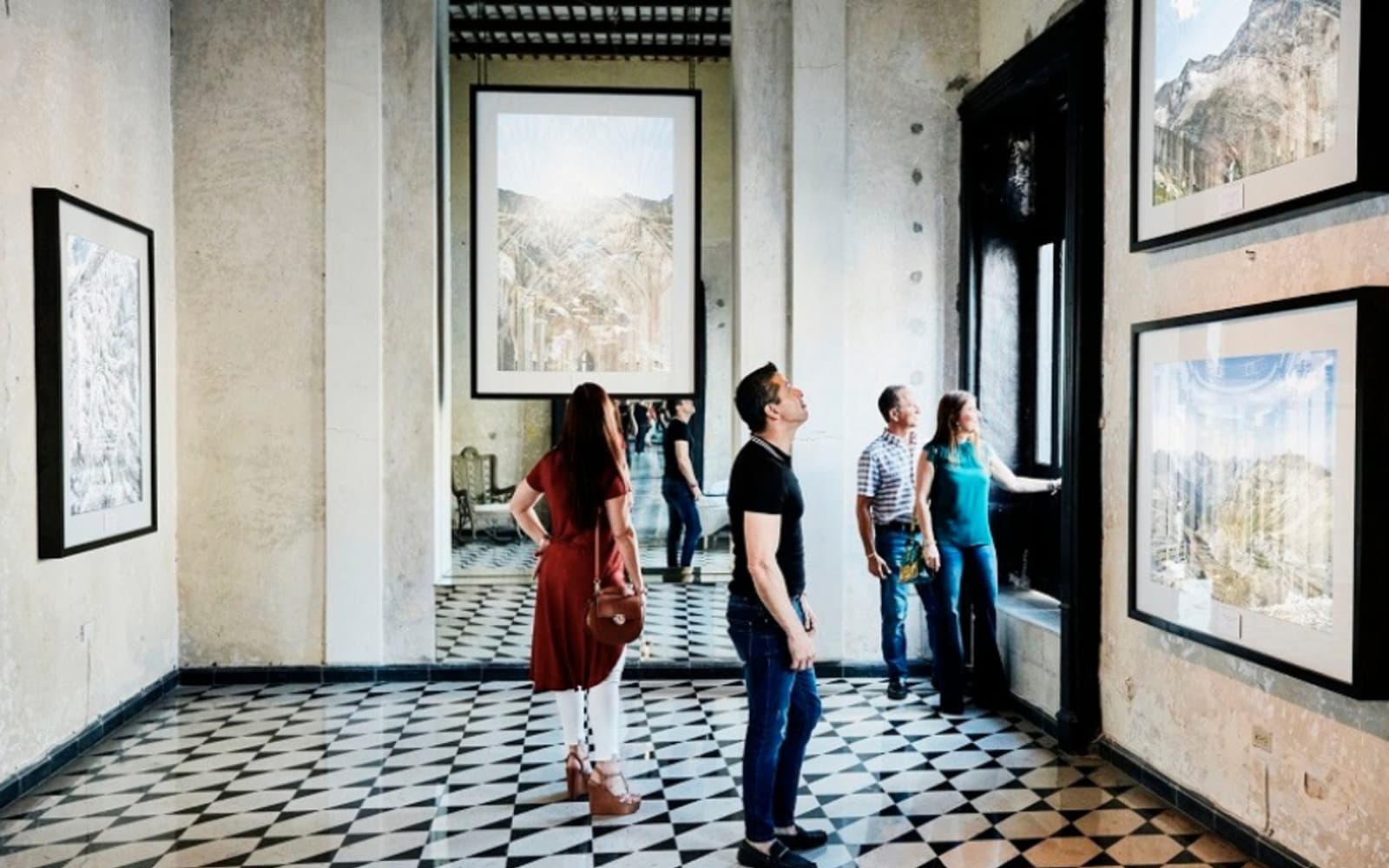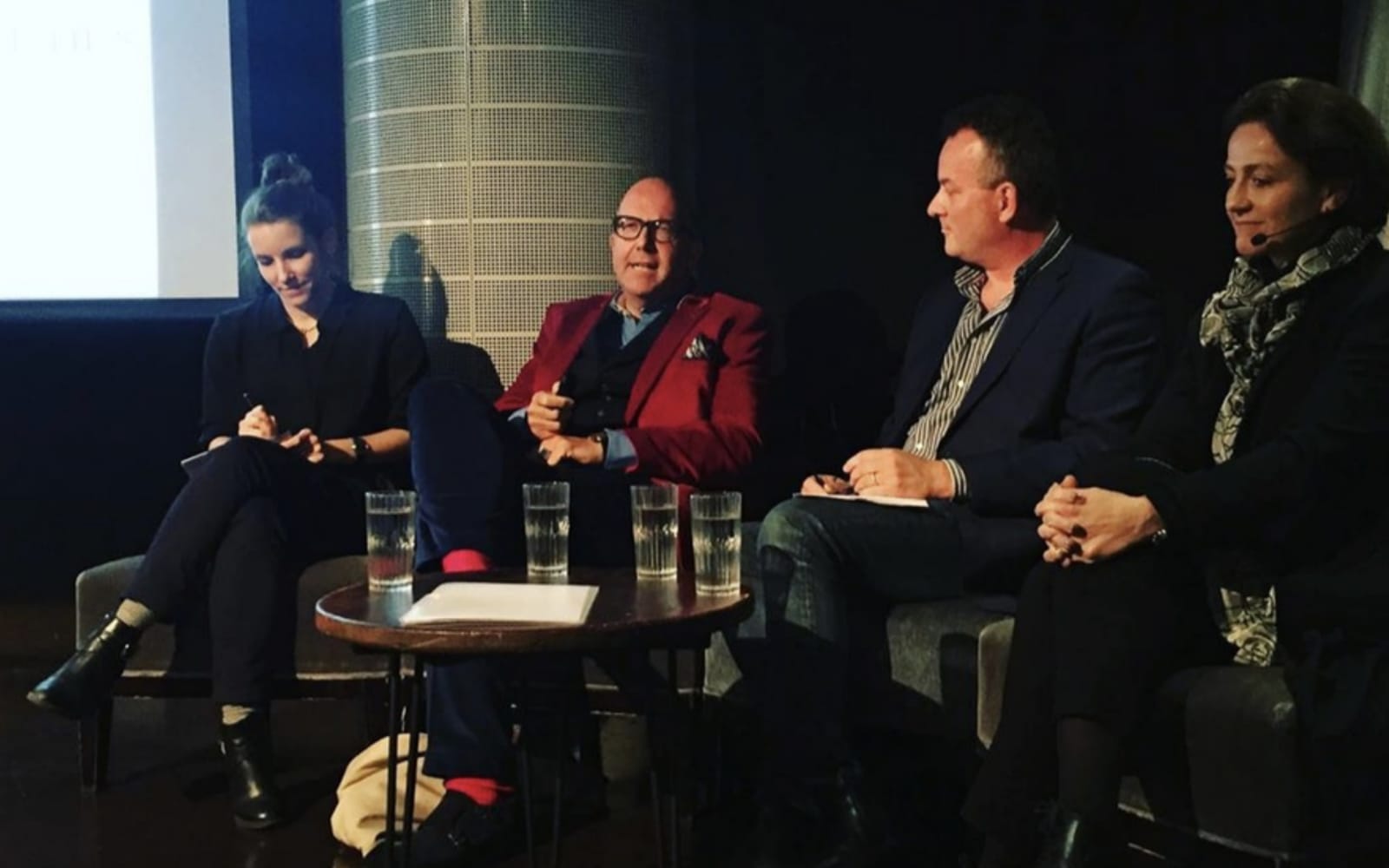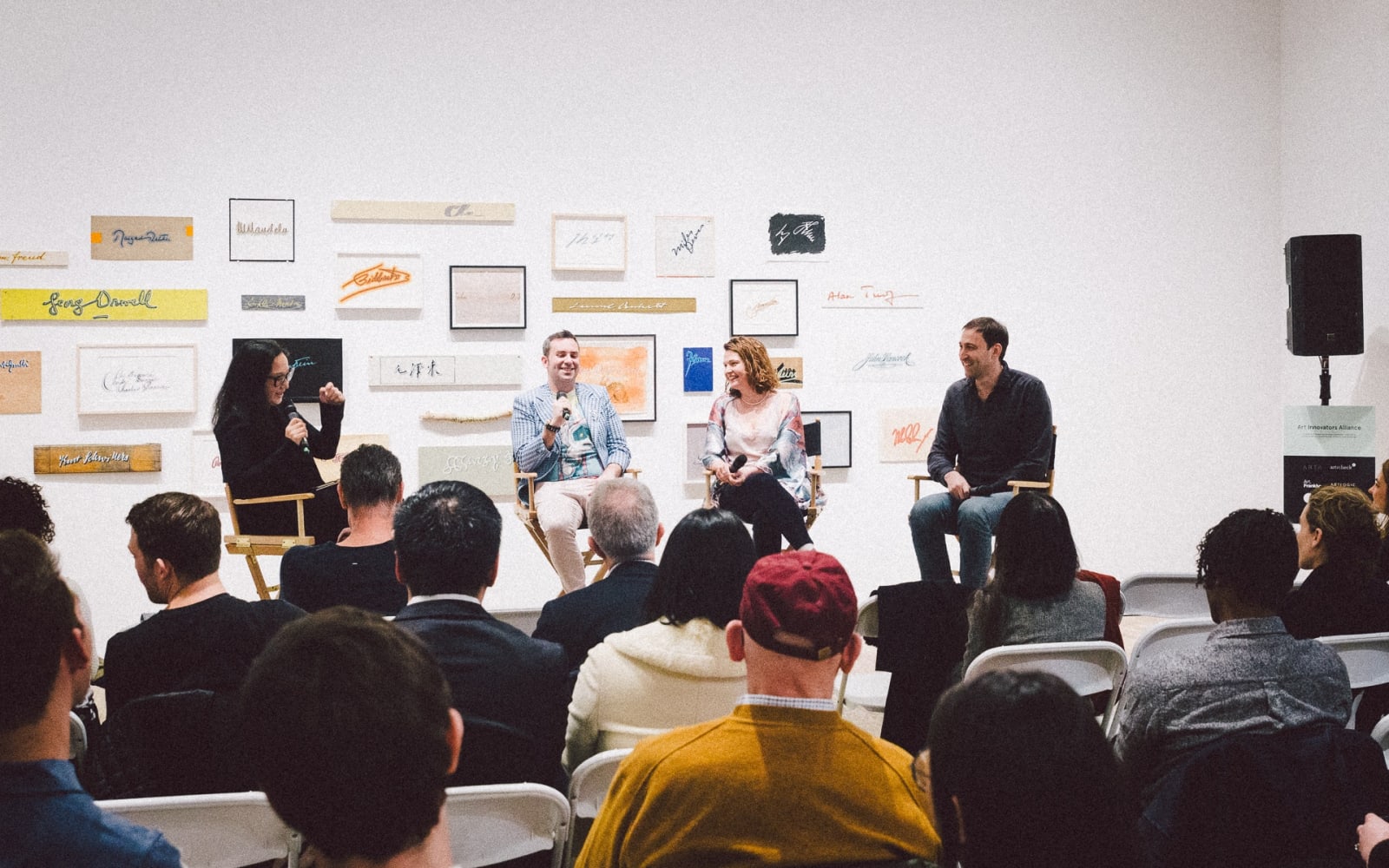-
July 29, 2020
Surviving a Pandemic: AIA Members Seek to Collaborate, Educate, and Support Art Businesses
According to the Hiscox Online Art Trade Report 2020, the immediate onset of the COVID-19 global pandemic hit the art world hard, particularly because the industry simply had not yet fully committed to enacting digital strategies to support their businesses. "For most traditional art world operators, the pandemic has exposed an over-dependence on traditional channels (physical art fairs, gallery exhibitions, auctions etc.) An online presence is more likely now than ever before to keep the art world afloat," the report confirmed.
From day one, the Art Innovators has been committed to advancing the art industry through innovation and technology. We believe that technology is an indispensable tool for the art market and art world to grow sustainably, supporting artists, the art eco-system and the creative economy. This has never been more apparent and necessary than it is today. Given that the future of online and digital in the art world is here to stay, we hope to foster a community around these foward-thinking initiatives and how we can sustain the market and set businesses up for success in the future.
Below, we've linked to digital content created by Art Innovators Alliance members throughout the pandemic seeking to educate, share ideas and support one another during these unprecedented times. We will continue to list upcoming webinars, events, and other interesting content on this page as well.
ARTA
In a 6-part webinar series launched in the early days of the pandemic, "Perspectives: the Logistics of Running a Business During a Global Pandemic", ARTA spoke with a diverse group of leaders across the industry about the immediate impact on their businesses, the expected impact on future operations, and how technology is and will play a role in their new business strategies. You can view recordings of all the webinars on ARTA's blog, or, click below to watch a few of particular interest:
- Adam Fields in Conversation with Anne Pasternak, Director of the Brooklyn Museum
- Adam Fields in Coversation with Amanda Lo Iacono, Head of Evening Sale, 20th Century & Contemporary Art at Phillips
- Adam Fields in Conversation with Jessica Silverman, Owner of Jessica Silverman Gallery
Articheck
Articheck's ongoing weekly webinar series, "Art Evolve," brings in different perspectives on how to think about old practices in new ways, share advice from innovative pioneers, and inspire evolution in the art industry in a post-COVID world. Summaries and links to watch all past webinars can be found on Articheck's blog, or, click below to watch a few of particular interest:
- The Art Supply Chain During COVID-19
- Create Exceptional Online Viewing Rooms
- Curating OVRs: Creating an Art Experience Online
"Vastari Connects" is a virtual roundtable series bringing together key industry players to discuss current problems and potential solutions in the museum space. The series covers different topics such as revenue generating business models, digital integration and partnership opportunities, all designed specifically to help cultural institutions thrive in a post-Covid world.
You can view recordings of all the webinars on Vastari's YouTube Channel, or, click below to watch a few of particular interest:
-
February 18, 2020
Art & Tech panel discussion, Ludlow House NYC
Exploring the impact of technology in the art market, today and tomorrow
On February 18th about 60 people gathered at Soho House’s Ludlow House in New York City to attend a panel organized by the Art Innovators Alliance about technology in the art industry.
The panel was moderated by Marion Maneker, President and Editorial Director of ART News, who began the discussion by talking about the background of each panelist and how their career evolved into technology. Paul Becker, CEO of Art Money, an art fintech, spoke of his desire to bring best practice to the art world. After realizing that buyers, artists, and dealers all wanted the same outcome, Paul conceived Art Money as a win/win model to help all parties buy/sell more art.
Breaking down the barriers to collecting art was also an incentive for Adam Fields, CEO of ARTA, to start his company which provides logistics automation for both buyers and sellers. Adam, while working at online marketplace Artspace.com, realized that without an automated logistics solution it was difficult to seamlessly sell art online. This drove him to create ARTA, an automated shipping solution which has contributed towards the growth of online art sales.
The conversation then moved to how technology has facilitated new business models for “selling” art. The CEO of the newly formed PaceX, Christy MacLear, spoke about how this new division of blue-chip Pace Gallery makes it possible for the creators of experiential tech or engineering-based art to get paid through revenue from ticket sales.
The fourth panelist, tech artist and professor, John Benton, spoke about how technology has decimated and recreated virtually every industry, but in different ways. Becker also mentioned how most industries that have been disrupted have removed the middleman. However, in the art business, the “middleman” is private galleries that do add value as taste-makers and advocates for their artists. Fields added that, although a bit behind other industries, galleries are starting to embrace technology and many of the blue-chip galleries now employ Chief Technology Officers.
Transparency and access to information were an area that all panelists felt needed to improve in order to provide an ‘on-ramp’ for new collectors. MacLear mentioned that the two things she would like to see improve are the access to data as well as scholarship. She mentioned how publishing more digital catalogue raisonnes would help enhance image rights as well as pricing transparency.
Interestingly, the “Burningmanization” of the art world was another way the panelists felt that things were changing. MacLear remarked that experiential art is appealing more to broader audiences, especially when technology is used to create art that has a humanist approach. This was a great example of tech as an ‘enabler’ for the art world, allowing more people to feel included and engaged; providing another ‘on-ramp’ into the art world.
Overall, it was agreed that tech was reaching out and influencing more of the art world than perhaps is immediately obvious. The panelists were united in believing that this is an advancement, as tech for its own sake is not the objective. Technology that can deliver positive change and better outcomes for artists, buyers, and the industry should be the focus.
John Benton, the digital artist and NYU Professor on the panel, perhaps best summed up the current place of tech in art with the astute observation that ‘it’s just the beginning’.
Listen: full panel discussion here (45 mins, Q&A at 47 mins)
Words: Edie Meyer, Vastari -
January 17, 2020
A conversation about empowering people to engage with and buy art
with Paul Becker, Founder & CEO of Art Money, and one of the founding members of the Art Innovator Alliance
The Withers Art team, sat down with Paul Becker, Founder & CEO of Art Money, and one of the founding members of the Art Innovator Alliance, to speak about the Alliance and how Art Money is empowering people to engage with and buy art. That empowerment has allowed for the development of a new generation of collectors. In this spirit, on January 18, 2020, Paul is speaking on a panel with Withers’ Kimberly Almazan at the fourth annual UNTITLED Art Fair in San Francisco about what new collectors need to know when building an art collection, including methods and tips for curating a collection and what current market trends exist.
To start, could you please tell me about yourself and about Art Money?
Art Money empowers people to buy art while supporting artists and a sustainable creative economy. I founded Art Money because I thought it was too difficult for people to engage with and buy art. I saw a broken and inefficient art ‘market’ and I thought I could do something about that. I believe we can increase demand and help develop the next generation of collectors by making art easier to buy with our win-win business model.
As a founding member of the Alliance, what excites you about its mission?
When like-minded creative problem-solvers get together, magic can happen. Art Innovators Alliance is a formal expression of our desire to make sustainable culture change in our industry. As a group of founder-led businesses, we are all solving problems that we have experienced in our industry, and we are stronger together.
How is Art Money employing innovation and/or technology to break the mold on the typical art sales transaction?
We make it easier for buyers to get to ‘yes’ (they can pay in ten installments, over the course of ten months, with no interest) and for artists and galleries to sell art (in return for a 10% commission, we pay them immediately and take the risk). We are fin-tech enabled, using APIs and algorithms to make real-time credit evaluations. As a result, a new client can be credit-approved in seconds via their mobile phone and can then purchase a $50,000 painting from a gallery or at an art fair in less than five minutes.
How do you envision the art market evolving as a result of companies like Art Money?
We want to empower more people to discover and purchase art, increase demand for art, nurture the next generation of collectors, and support artists. We want to support culture and a sustainable creative economy. We want to bring best practices from other industries to the art market and, by adopting them, facilitate a larger, healthier, and more sustainable art market, particularly at the grass roots.
What trends or innovative art ventures are you seeing emerge that you’re excited to watch develop and grow?
Without picking specific businesses – look at the membership of the Art Innovators Alliance if you want to do that – I think an industry trend for collaboration, rather than for competition, is one I’d like to see continue. This is a very fractured industry, with only a few big players (who are doing fine). For everyone else, it is important to think outside the box and find new ways to reach markets, share costs, increase efficiency, and consider new business models.
The art market is often criticized for being opaque. How can companies in this world work to improve transparency and open communication in a way that benefits parties on both sides of art transactions?
A lack of transparency suits some players, but it is old school thinking and ultimately limits the growth of the market by pushing people away. I think companies have to demonstrate through their products and actions how transparency leads to market growth.
One last question: What do you hope the Alliance achieves in the future, both for its members and for its supporters?
I hope we can accelerate change in a good way, in an industry that is very conservative in its business practices. We can educate and inform and, most importantly, we can demonstrate practical solutions. We can lead.
Authors: Kimberly Almazan & Kenley Stark, Withersworldwide
Published 17 January 2020: https://www.withersworldwide.com/en-gb/insight/art-money-a-conversation-about-empowering-people-to-engage-with-and-buy-art -

An Art Innovators Alliance panel discussion, London, 24 September 2019, at h Club.
Panelists (l to r in photo):
Host: Bernadine Brocker Wieder, Vastari Co-founder
Philip Hoffman, Founder & CEO of The Fine Art Group
Ivan Macquisten, Writer, Commentator, Analyst, Collector
Christine Bourron, Founder & CEO Pi‐eXReport by Articheck's Claire Trevien
Trust and transparency go hand in hand, and it was the most hotly debated topic at London’s Art Innovators Alliance debate, moderated by Bernadine Brocker Wieder, Vastari’s Co-founder. Old school approaches clashed with modern sensibilities – a microcosm of what plays out on a larger scale in the art world. With only so much data available and advisors at every corner, where can buyers and sellers find information that they can trust, and how can the art market, in the widest sense of the term, make itself seem less opaque?
The panel discussed the amount of fraud taking place year on year in the art market. Art analyst Ivan Macquisten estimated that if there was greater transparency, an average of 10 billion of trades wouldn’t go through every year. While this figure might not be 100% accurate, he uses it to explain the magnitude of the problem: from works found illegally, to unfair prices, and fraudulent practices. “To me, the biggest cost of the non-transparency of the art market is all the people who could have potentially invested in the art market, and who do not because they’re scared of it all”, added Christine Bourron, CEO and Founder of Pi-eX.
However, getting reliable data is not as straightforward as it sounds. Bourron believes that the most essential requirement to an investment is data, “and then you need to evaluate your investment”. On the other side of the argument, Philip Hoffman, Founder and CEO of The Fine Art Group, claimed that “the data makes no difference to the art market. I don’t look at any charts, they can all be manipulated”. While his statement was deliberately flippant, and it’s likely he does still employ and rely on charts and data, the point that data is never neutral is an important one to remember. To Bourron, interpretation of data is, of course, essential, but so is honesty about the data: “you cannot hide a part of the data”.
There is also, of course, the notion of “the art market” to contend with, as Macquisten is keen to point out: “there is no such thing as the art market, instead there are hundreds of micro markets.” In this, he echoes Clare MacAndrews’ notion that the art market is a vast array of “independently moving submarkets that are defined by artists, genres, price points, and geographical locations”.
Should we trust “honest” data, or the expertise of the likes of Hoffman? Data only takes you so far before experts and their assumptions have to take over – a point made by Bourron across the evening. Reputable sources, such as Clare MacAndrews’ Art Basel report, are also by necessity built on assumptions – since many of the sources aren’t accessible (for example those related to private sales). To some extent, Macquisten argued, the exact figures aren’t necessarily all-important – but getting enough to make informed decisions is.
It seems unlikely that we will see the “art world” adopt the approach of tech companies such as Buffer who have opted for 100% transparency on all levels from salaries and fundraising to their coding. As the panel made clear, in the art world, those who demand transparency are rarely transparent themselves. Will transparency also cause harm to some companies’ businesses due to less scrupulous ones?
While not all of the panellists were on board for full transparency, the consensus seemed to be that they all thought more work was needed to improve trust with future art investors if businesses want to keep navigating smoothly in the future.
-
April 9, 2019
The Road Yet Travelled
What art businesses can learn from other industries about technology adoption and transformation
An Art Innovators Alliance launch & panel discussion, New York, 19 March 2019, at Postmasters Gallery.
Panelists:
Tony Aiazzi, CEO & Co-founder, Chouxbox
Daniel Doubrovkine, CTO, Artsy
Annika Erikson, Founder & CEO, ArtiCheck
Alex Mitow, Director of Superfine! Art Fair, former restaurateur
Nathan Richardson, Co-founder Trade-it, former CEO Gilt City
Moderator: Elisa MalaOn a still winter's night at Postmasters Gallery in Tribeca NYC, a new industry voice, Art Innovators Alliance, was launched with a panel discussion around tech and innovation for the arts.
An audience of 100 people heard a panel discussion titled The Road Yet Travelled: What art businesses can learn from other industries.
Speakers included Artsy CTO Daniel Doubrovkine, Superfine! Art Fair co-founder & Director Alex Mitow and Annika Erikson, founder & CEO of Articheck as well as panelists from the fashion & food industries.
The panel explored ways technology had changed those industries, for better or worse, and then drew parallels with the art industry before exploring the challenges and opportunities ahead.
Topics covered included
• the impact of mobile on the fashion industry: 'game-changer'
• the unexpected importance of the 'tactile' nature of images being presented (ie people want to know exactly what they are going to get)
• the importance of empowering non business types (eg chefs)
• The Seamless/Uber eats experience in the food world - how B2C (client driven demand) drove the change in B2B sales (restaurants had to be part of it)
• It's never been easier to harness tech to new business models (API's can solve anything!)
• The challenges of getting people to change when they've been doing something the same way for years (change habits, not just try something once)
• 'Data is the key' - create personalised, unique experiences utilising data (in everything from email to product)
• Lessons learned included 'concentrating on what people want rather than what we thought they needed; be rational and data driven; don't let your ego get in the way
• Be where the people are: thoughts on Instagram, Google etc
• The merits of using existing tech rather than building custom solutions that don't integrate or use industry standards
• Competitors or collaborators? What's best for the art industry?
• Transparency (or the lack thereof) in the art world and who does that actually benefit?
• Some best practice examples of art businesses using tech
• What are the challenges of bringing art into the tech world?
• Is tech v art so different? Although the art world is resistant to tech, both are creative endeavoursListen to the full podcast here.
Introductions (6 mins)
Session One: Innovation in Food & Fashion (29 mins)
Session Two: Innovation in the Arts (36 mins)Photo left to right: Alisa Mala; Alex Mitow, Superfine!; Annika Erikson, Articheck; Daniel Doubrovkine, Artsy. Works by artist Joe Amrhein. Courtesy Postmasters Gallery. Photo Erik Erikson
-
April 4, 2019
The Art Innovators Alliance: A conversation
A Flash Art, Parallels interview by Diana Wierbicki with Edie MeyerThe Art Innovators Alliance is an alliance of forward-thinking art businesses committed to advancing the art industry through innovation & technology. Created by eight founding members: ARTA, Articheck, Artlogic, Art Frankly, Art Money, Tagsmart, Vastari and Verisart.
Diana Wierbicki, global head of Withers’ Art team, sat down with Edie Meyer of Vastari, one of the founding members, to speak about the background of the Alliance, her insight on the art and technology industries and looking ahead.
-
January 23, 2019
Technology’s Impact on the Art Industry Today & Predictions for the Future
National Arts Club, NYC
A packed room at the venerable National Arts Club in New York City was the venue for a January 23 panel discussion entitled “Technology’s Impact on the Art Industry Today and Predictions for the Future”. Moderated by Natalia Kolodzei of the Kolodzei Foundation, the panel included Bernadine Brocker of Vastari, Adam Fields of ARTA and Andrew Goldstein, the Editor-in-Chief at Artnet News.
The evening included a lively discussion around the adoption of current technology in the art world and what these leaders predict for the future. In the audience was a mix of attendees, including representatives from companies involved in art and technology ranging from Artsy to Artlogic to Collector Systems. Having so many experts in the audience as well as on stage meant that there were interesting debates and discussions in the initial conversation and the subsequent Q&A.
The discussion started with the background to how each of the three companies have been involved in digitising the art world, in the order of each company’s founding date. Artnet is greatly known for its pricing database, but also increasingly through the popularity of its email-based editorial content known as artnet news. Andrew’s experience also spans to another initiative for digitising the art world, called Artspace, a company selling art online which was sold to Phaidon in 2014.
Bernadine Brocker Wieder described how Vastari was founded, from a desire to make more connections between collectors of art and museums for exhibitions. Adam Fields, who also worked at Artspace, described how his work selling art online exposed the inefficiencies in sending art using global logistics suppliers. He set up ARTA in 2014 to make it easier for art marketplaces, auction houses and galleries to get a variety of quotes for shipping their art around the world.
As the discussion coincided with the beginnings of the Art Innovators Alliance, there were also questions about best practices, security online and issues with art market players embracing technology.
Natalia led the conversations in a variety of directions, weaving from questions more related to the interests for artists, to those related to galleries and museums. Looking at how the art world has evolved from the 90’s to today, the conversation then evolved to what people can expect in the future.
One of the points that resonated most about this panel discussion was the importance of engagement from collectors, galleries and artists. Unless they are aware of the importance of technology and the security that these applications are providing, there is limited impact for innovation and technology.
Interestingly, the companies expressed less concern about upcoming competition and were more worried about finding sustainable financial models that can help continue the growth. There is a certain expectation from the industry to constantly receive services for free, which can be difficult for the companies that are providing the services. “Nothing in life is free” said Bernadine, “so if you are getting services for free, then the company offering you the services may be selling your data.”
Raising awareness of these issues for the art world, and how innovation can be transformative in a positive way, is why the Art Innovators Alliance was founded. The Innovators will officially launch on 19 March 2019 with an industry panel discussion at Postmasters Gallery in NYC. Book here.
-
November 26, 2018
11 Art World Entrepreneurs you should know: Adam Fields, Arta
Sotheby's Institute 2018 list
-
November 26, 2018
Women you should know: Bernadine Brocker
Art Tactic interviews Bernadine Brocker, Co-founder & CEO, Vastari
-
![The next generation of [art] collectors…](https://artlogic-res.cloudinary.com/w_1600,h_1000,c_fill,f_auto,fl_lossy,q_auto:good/ws-artinnovatorsalliance/usr/images/blog_entries/main_image/items/66/66c5b7398c0a49c58cb70536508e654c/ams1.jpg)

